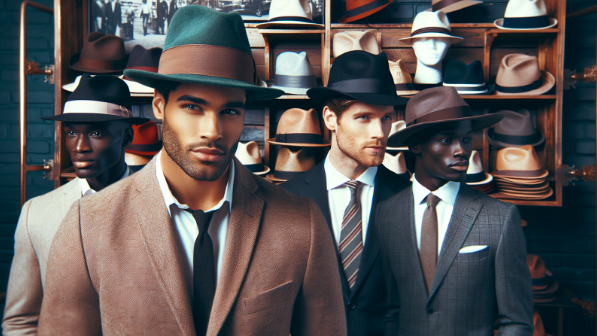Mastering the Fedora: A Classic Hat That Defines Timeless Elegance

Introduction to the Fedora Hat
The fedora hat is a timeless accessory that has been a staple in men’s fashion for over a century. Known for its distinctive shape and stylish appearance, the fedora has been worn by iconic figures throughout history, from gangsters to Hollywood stars. In this comprehensive guide, we’ll explore the fascinating world of fedora hats, their history, styles, and how to incorporate them into your wardrobe.
The History of the Fedora Hat
Origins and Early Popularity
The fedora hat originated in the late 19th century, with its name derived from the titular character in the play “Fédora” by Victorien Sardou. Initially popular among women, the fedora gained widespread acceptance among men in the 1920s and 1930s, becoming a symbol of sophistication and style.
The Golden Age of Fedoras
During the mid-20th century, the fedora reached its peak popularity. It was a common sight on the streets, worn by businessmen, politicians, and celebrities alike. The hat’s versatility and timeless appeal made it a go-to accessory for any occasion.
Decline and Resurgence
In the latter half of the 20th century, the fedora’s popularity began to wane as casual fashion trends took over. However, in recent years, there has been a resurgence of interest in classic style, leading to a renewed appreciation for the fedora hat.
Anatomy of a Fedora Hat
The Crown
The crown is the top part of the fedora hat and is typically creased lengthwise down the centre, with pinches on either side. The height and shape of the crown can vary, allowing for different styles and personal preferences.
The Brim
The brim is the wide, flat part of the hat that extends around the circumference of the crown. Fedora brims are usually between 2 to 3 inches wide and can be shaped in various ways, such as snapped down at the front or turned up at the back.
The Band
A ribbon or band is often wrapped around the base of the crown, adding a decorative touch to the fedora. The band can be made of different materials, such as grosgrain or leather, and can feature various colours and patterns.
Fedora Hat Materials
Felt
Felt is the most common material used in the construction of fedora hats. It is made from wool, fur, or a combination of both, and is known for its durability and ability to hold its shape.
Straw
Straw fedoras are a popular choice for summer wear, as they are lightweight and breathable. They are typically made from materials like panama, raffia, or toyo and offer a more casual look compared to their felt counterparts.
Other Materials
While felt and straw are the most prevalent materials for fedora hats, other options include leather, cotton, and even synthetic fibres like polyester.
Choosing the Right Fedora Hat
Face Shape and Proportions
When selecting a fedora hat, it’s essential to consider your face shape and proportions. Different crown heights and brim widths can complement or clash with certain facial features, so it’s crucial to find the right balance.
Occasion and Dress Code
The occasion and dress code should also influence your choice of fedora. A classic felt fedora in a neutral colour is suitable for formal events, while a straw fedora may be more appropriate for casual summer outings.
Personal Style
Ultimately, your personal style should be the driving force behind your fedora selection. Choose a hat that reflects your individual taste and complements your existing wardrobe.
Styling Tips for Wearing a Fedora Hat
Coordinate with Your Outfit
When incorporating a fedora into your outfit, consider the colour, texture, and overall style of your clothing. The hat should harmonise with the rest of your ensemble, rather than clash or appear out of place.
Confidence is Key
Wearing a fedora with confidence is essential to pulling off the look. Stand tall, wear the hat at a slight angle, and embrace the sophistication and elegance it brings to your appearance.
Experiment with Different Looks
Don’t be afraid to experiment with different fedora styles and combinations. Try pairing your hat with various outfits, from suits to casual attire, to find what works best for you.
Fedora Hat Etiquette
When to Wear and Remove Your Hat
Traditional hat etiquette dictates that men should remove their hats when indoors, during meals, or in the presence of a national flag. However, these rules have relaxed in recent times, allowing for more flexibility based on the setting and occasion.
Tipping and Greeting
Tipping your fedora is a classic gesture of respect and greeting. When meeting someone or acknowledging a passing acquaintance, a subtle nod or tip of the hat is a polite way to show recognition.
Handling and Storing Your Fedora
To maintain the shape and quality of your fedora, handle it by the brim and avoid placing it on its crown. When not in use, store your hat on a hat rack or in a hat box to prevent damage and ensure longevity.
Famous Fedora Wearers
Icons of Style
Throughout history, numerous iconic figures have been associated with the fedora hat. From Frank Sinatra and Cary Grant to Indiana Jones and Michael Jackson, these individuals have contributed to the enduring legacy of the fedora.
Fedoras in Popular Culture
The fedora has been featured prominently in films, television shows, and music videos, often symbolising mystery, sophistication, or a nod to a bygone era. Its presence in popular culture has helped to maintain its status as a timeless accessory.
Caring for Your Fedora Hat
Cleaning and Maintenance
Regular cleaning and maintenance are essential to keep your fedora looking its best. Brush the hat with a soft-bristled brush to remove dust and dirt, and spot-clean any stains with a damp cloth. For more thorough cleaning, consider professional hat cleaning services.
Storing Your Fedora
Proper storage is crucial to maintain the shape and integrity of your fedora. Use a hat rack or hat box when not wearing it, and avoid placing heavy objects on top of the hat to prevent distortion.
Repairing and Reshaping
If your fedora becomes misshapen or damaged, don’t despair. Many hat retailers offer repair and reshaping services to restore your hat to its former glory.
Fedora Hat Trends and Variations
Contemporary Styles
While the classic fedora shape remains popular, contemporary designers have introduced new variations and twists on the traditional style. From unconventional materials to unique colour combinations, there are countless options for those seeking a modern take on the fedora.
Seasonal Adaptations
Fedora hats can be adapted to suit different seasons and weather conditions. Lightweight, breathable materials are ideal for summer, while thicker, insulated options provide warmth during colder months.
Conclusion
The fedora hat is a timeless accessory that has withstood the test of time. Its classic style, versatility, and enduring appeal make it a must-have for any fashion-conscious individual. By understanding the history, anatomy, and etiquette of the fedora, you can confidently incorporate this iconic hat into your wardrobe and embrace the sophistication and elegance it represents.


